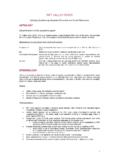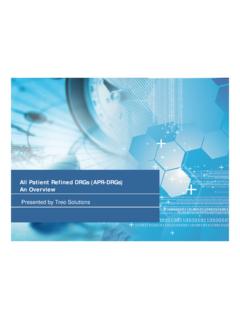Transcription of Dependence vs. Abuse vs. Use - wvupc.com
1 Dependence vs. Abuse vs. UseWVUPCL aura Sullivan, MSW, CPC1 Dependence , Abuse or Use?Get ready to change your mindset when choosing a diagnosis code for substance use, Abuse , or Dependence under ICD-10. Current ICD-9 codes focus on the patterns of use (episodic, continuous, or unspecified), but you'll need to define acute or chronic use to pinpoint the right code under the provider documentation refers to use, Abuse and Dependence of the same substance( eg, alcohol, opioid, cannabis, etc.), only one code should be assigned to identify the pattern based on hierarchy:1. If both use and Abuse are documented, assign only the code for abuse2. If both Abuse and Dependence are documented, assign only the code for dependence3. If both use and Dependence are documented, assign only the code for dependence4. If use, Abuse , and Dependence are all documented, assign the code for drug users take more than one type of drug, but the diagnosis of the disorder should be classified, whenever possible, according to the most important single substance (or class of substances) used.
2 This may usually be done with regard to the particular drug, or type of drug,causing the presenting disorder. When in doubt, code the drug or type of drug most frequentlymisused, particularly in those cases involving continuous or daily Health Code SetsF01-F09 Mental disorder due to known physiological conditionsF10-F19 Mental and behavioral disorder due to psychoactive substance useF20-F29 Schizophrenia, schizotypal, delusional and other non-mood psychotic disordersF30-F39 Mood (Affective) DisordersF40-F48 Anxiety, dissociative, stress-related, somatoform and other nonpsychotic mental disordersF50-F59 Behavioral syndromes associated with physiological disturbances and physical factorsF60-F69 Disorders of adult personality and behaviorF70-F79 Intellectual disabilitiesF80-F89 Pervasive and specific developmental disordersF90-F98 Behavioral and emotional disorders with onset occurring in childhood and adolescence4 Drug Use A pattern of psychoactive substance use that is causing damage to health.
3 5 Drug UseThe damage may be physical (as in cases of hepatitis from the self-administration of injected drugs) or mental ( episodes of depressive disorder secondary to heavy consumption of alcohol).The diagnosis requires that actual damage should have been caused to the mental or physical health of the Abuse Desire to have the drug 7 Drug AbuseDrug abuserefers to an individual who continues to use drugs even though they know it is having an adverse affect on their health and well being. Drug abusers will continue to use even though their social life is falling apart and their financial stability is Diagnostic and Statistical Manual of Mental Disorders, describes drug Abuse as a "maladaptive pattern of substance use manifested by recurrent and significant adverse consequences related to the repeated use of substances. A diagnosis of substance Dependence supersedes a diagnosis of substance Abuse , therefore if the criteria for substance Dependence are met, then the additional diagnosis of substance Abuse is not Drug Abuse Use of the drug in question has led to poor performance at school or on the job.
4 The individual uses the drug in situations that are potentially harmful to himself or others ( , while driving, caring for children, etc.). The individual incurs legal problems as a result of the drug use. The individual experiences considerable social problems as a result of the drug use ( , losing old friends, martial difficulty, etc.)9 Dependence A physiological need to have the drug 10 DependenceDrug Dependence occurs when an individual has built up a tolerance to a particular drug or drugs. With tolerance comes the need to take more and more of the drug in order to achieve a high . Those with a drug Dependence problem are also likely to experience withdrawal symptoms when they stop taking the drug in question. Just as in drug Abuse , a person with a drug Dependence experiences similar counterproductive patterns of substance use which causes significant impairment or distress. To diagnose Dependence , however, additional criteria must be met.
5 These criteria include developing tolerance to the drug; experiencing withdrawal symptoms upon cessation of the drug; taking more of the drug than intended; unsuccessful attempts to cut down usage; spending a great deal of time obtaining the drug; foregoing important activities because of drug use; and continued use of the drug despite knowing its harmful Building a tolerance for the drug. This may included the need to take more and more of the drug to get its desired effect, or a lessening of the effect one gets when they continue to take the same amount of the drug. Withdrawal symptoms. These may include physical and psychological symptoms such as nausea, sleeplessness, irritability, muscle aches, etc. The length of time that withdrawal symptoms are experienced varies according the individual and the intensity of the drug addiction, but as a general rule, they will last between two to five days.
6 The inability to stop taking the drug(s) in question The individual takes more and more of the drug over time. More than he or she originally had intentioned. The individual becomes obsessed with the drug, and the pursuit of it begins to overtake their In remission Without remission Affecting newborn Complicating pregnancy Fetal damage In family Korsakov s Screening13If in pregnancy must state the following:-Weeks of gestation-Current use or past use- Dependence or Abuse -Any associated disorders-Trimester-Delivered-Outcome of delivery-Single, twins-Live, stillbornAlcohol Level Less than 20mg/100ml 20-39 mg/100ml 40-59 mg/100ml 60-79 mg/100ml 80-99 mg/100ml 100-119 mg/100ml 120-199 mg/100ml 200-239 mg/100ml More than 240 mg/100ml14 Alcohol NOS CodesWhen the alcohol use is not specified as dependent or Abuse the code selected should be the series; which states Alcohol Use NOS. Still must document if the patient has any complications.
7 -Psychotic disorder-with delusions-with hallucinations-Mood disorder-Intoxication-with delirium-Alcohol level must also be coded-Dementia-Anxiety-Sexual Dysfunction-Sleep disorder-Delirium15 Use and/or Dependence Alcohol (use= Dependence ) Amphetamine Caffeine Cannabis Cocaine Hallucinogen Hypnotic Inhalant Methadone Non-prescription16-Opioid-Patent Medications-Polysubstance(indiscriminate drug use)-Psychoactive -Sedative-Tobacco-Volatile solventWhile to the provider the word use is not the interchangeable with Dependence in coding they can be the sameDependence-Intoxication-Perceptional disturbance-Delirium-Withdrawal-Induced disorder-Mood disorder-Psychotic disorder-Hallucinations-Delusions17-Slee p disorder-Sexual dysfunction-Pre-existing psychiatricdisorder/s-Anxiety-Depression -Specify drug and categoryUncomplicated DependenceF1220 -Cannabis Dependence uncomplicatedF1420-Cocaine Dependence uncomplicatedF1120-Opioid Dependence uncomplicatedUncomplicated defined as.
8 -No delirium-No psychotic disorder-No delusions-No sexual dysfunction-No intoxication-No sleep disorder-No mood disorder-No withdrawal-No perceptual disturbance18 Abuse of AlcoholAmphetamine (code as stimulant)Anxiolytics (barbiturates, phenobarbital, tranquilizersCaffeine (code as stimulant)Cannabis, cannabinoidsCocaineHallucinogen (LSD, mescaline, peyote)InhalantsMultiple drugsNon-prescribed substance, non Dependence Opioids ( codeine, heroin, methadone, morphine)Patent medicines, maternal, affecting newbornPhencyclidine (PCP)StimulantVolatile solvents19 Use of:Cannabis-Anxiety disorder-Delirium-Delusions-Hallucinatio ns-Intoxication-Perceptual disturbance-Psychosis20 Hallucinogen -Anxiety-Delirium-Delusions-Flashbacks-H allucinations -Intoxication-Mood disorder-Persisting perceptual disorder-Psychotic disorderCaffeine aka Stimulant-Anxiety disorder-Delirium-Delusions-Hallucinatio ns-Intoxication-Mood disorder-Perceptual disturbance-Psychotic disorder-Sexual dysfunction-Sleep disorder-WithdrawalTobaccoComplicating pregnancy -Last menstrual period-Weeks of gestation-Other complicationsHistory of nicotine and/or Dependence -Follow up after completion of treatment-Personal history of self harmDependence-Chewing Tobacco-CigarettesUse Lifestyle problems (see next slides))
9 -Education and/or literacy problems-Employment problems-Life management difficulty-Occupational exposure to risk factors-Problems with housing/economic circumstances-Problems with family -Psychosocial problems-Social environment problems 21 Lifestyle issues in Tobacco Use22 Lifestyle problems-Education and/or literacy problems-Failed exams-Low level literacy-Maladjustment with teachers-School unavailable-Underachievement in school Employment problems-Change of job-Discord with boss and/or workmates-Environment-Military deployment status-Sexual harassment-Stress-Threat of job loss-UnemploymentLife management difficulty-Occupational exposure to risk factors-Problems with housing/economic circumstances-Problems with family -Psychosocial problems-Social environment problems Occupational risk-Dust-Environment tobacco smoke-Extreme temperature-Noise-Radiation-Toxic agents-VibrationLifestyle issues in Tobacco Use23 Housing and/or economic issues-Boarding school resident-Discord with neighbors/landlord-Extreme poverty-Foreclosure on loan-Homelessness-Inadequate drinking water supply-Inadequate housing-Insufficient social insurance/welfare-Isolated dwelling-Lack of adequate food-Lack of heating-Low income-Problems related to living in residential institution-Problems with creditor-Restriction of space-Technical defects in home-Unsatisfactory SurroundingsProblems related to upbringing- Abuse -Altered pattern of family relationships-Custody and/or support proceedings-Emotional neglect of child-Frightening experience-Hostility towards and/or scapegoating of child-In foster care/welfare custody-Inappropriate parental pressure-Institutional upbringing-Living in orphanage or group home-Loss of relationship/self esteem-Parent child conflict-Parent child estrangement-Parental
10 Overprotection-Physical Abuse -Removal from home-Sexual Abuse -Sibling rivalryLifestyle issues in Tobacco UseProblems with family-Absence-Alcoholism and/or drug addiction-Anxiety about normal sick person -Death and/or disappearance-Divorce and/or separation-High expressed emotional level-In-laws-Isolated family-Return of a family member from military deployment-Spouse and/or partnerSocial Environment problems-Acculturation difficulty-Adjustment to life-cycle transitions-Adjustment to retirement-Atypical parenting-Empty nest syndrome-Exclusion and/or rejection -Living alone-Migration-Phase of life-Target of perceived adverse discrimination/persecution-Transplantati on24 Psychosocial Problem-Arrest-Child custody and/or support proceedings-Conviction in civil and/or criminal matter w/o prison-Discord with counselors, probation officer, social worker-Exposure to disaster, war or other-Imprisonment and/or incarceration-Litigation and/or prosecution-Multiparity-Release from prison -Seeking and/or accepting known hazard-Unwanted pregnancy-Victim of crime terrorism/torture-Other legal issuesBasics to remember- Dependence v Use v Abuse -Name of drug used-Associated Complications-Lifestyle Issues -Type of use, current, remission, history of, or withdrawal-Alcohol level if intoxicated or in withdrawal-In pregnancy, LMP and weeks of gestation-Contributing Factors25 Good Documentation-Notes must be signed and dated by ALL providers -Clear and concise chief complaint- diagnosis and plan clearly outlined -Use descriptors such as.






